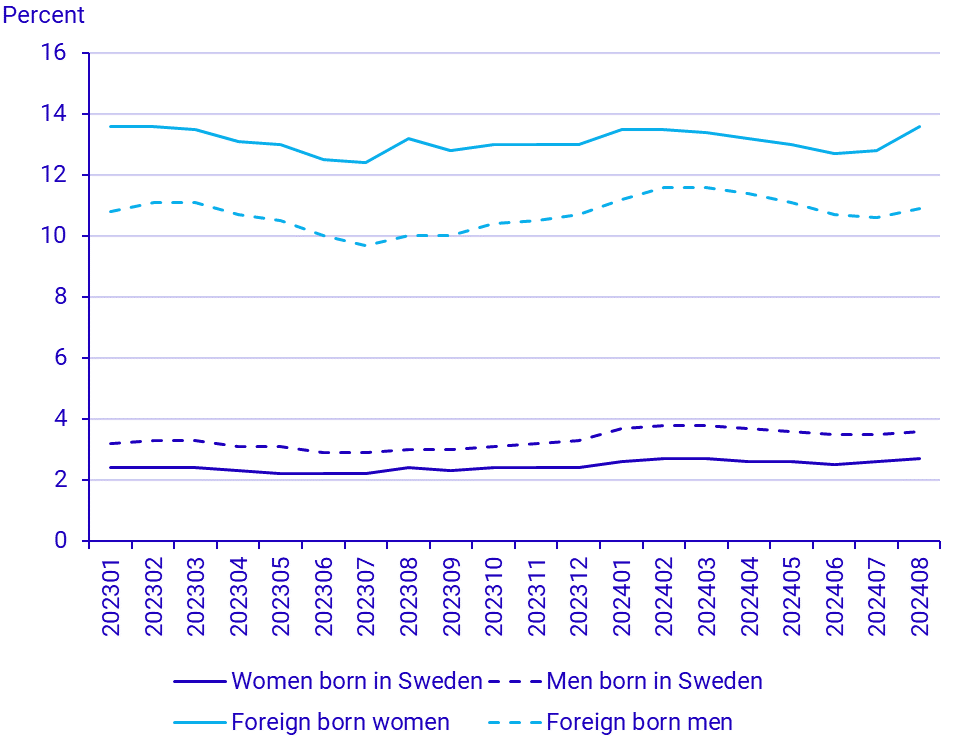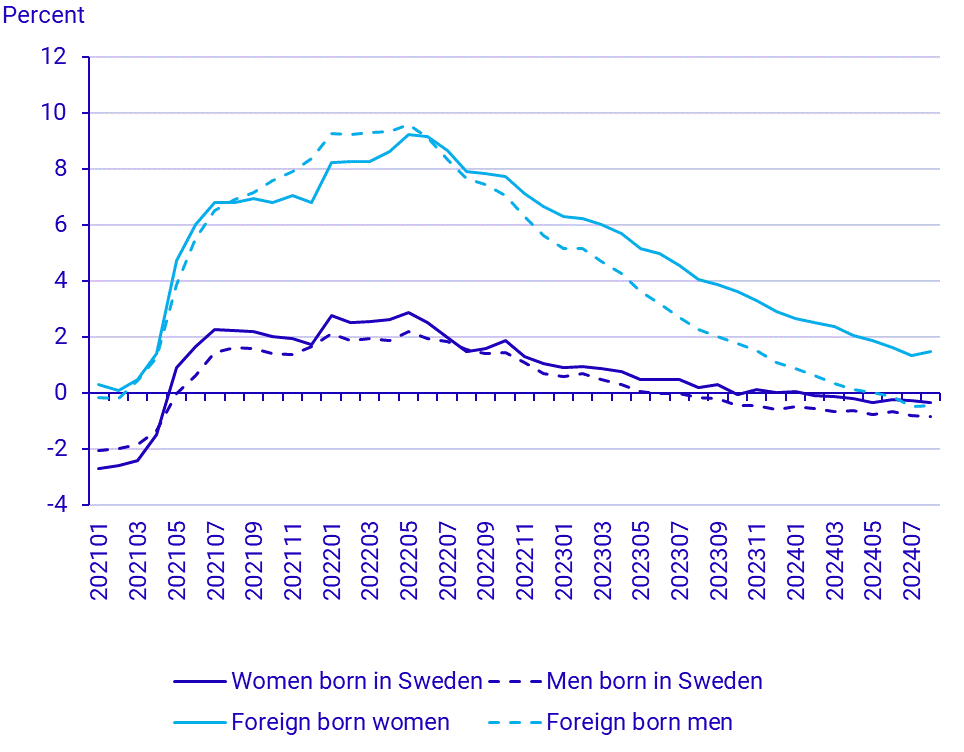Population by Labour market status, August 2024
Unemployment continued to increase in August 2024
Statistical news from Statistics Sweden 2024-10-31 8.00
People in employment aged 15 to 74 numbered 5 317 000 in August 2024. This is a decrease of 19 000 people compared with August 2023. In the 20 to 65 age range, 280 000 people were unemployed. This equals a share of 5.4 percent expressed as a percentage of the labour force and is an increase of 0.6 percentage point compared with the same period of the previous year.
The unemployed
The number of unemployed people aged 20 to 65 in August 2024 was 280 000, which is an increase of 29 000 compared to the same period the previous year.
The relative unemployment rate - the proportion of unemployed people in relation to the labour force - was the same for women and men, 5.4 percent. This equals an increased unemployment rate among woman of 0.4 percentage point, and 0.7 percentage point among men compared with the same period of 2023.
Unemployment is higher among foreign born people than among those born in Sweden. The relative unemployment rate was, among foreign born people, 13.6 percent for women and 10.9 percent for men. For people born in Sweden the relative unemployment rates was 2.7 percent for women and 3.6 percent for men in August 2024.

People in employment
The number of people in employment aged 15 to 74 decreased in August 2024 by 0.4 percent compared to the same period the previous year, but the trend varies depending on sex and region of birth.

| August 2024 | July 2024 | August 2023 | Change since August 2023 (%) | |
|---|---|---|---|---|
| Employed | 5 317 000 | 5 367 000 | 5 336 000 | ‑0.4 |
| Women | 2 589 000 | 2 619 000 | 2 587 000 | 0.1 |
| born in Sweden | 2 024 000 | 2 047 000 | 2 031 000 | ‑0.3 |
| foreign born | 564 000 | 572 000 | 556 000 | 1.5 |
| Men | 2 729 000 | 2 747 000 | 2 749 000 | ‑0.7 |
| born in Sweden | 2 105 000 | 2 121 000 | 2 122 000 | ‑0.8 |
| foreign born | 624 000 | 627 000 | 627 000 | ‑0.4 |
| August 2024 | July 2024 | August 2023 | Change since August 2023 | |
|---|---|---|---|---|
| Employed | 4 880 000 | 4 907 000 | 4 897 000 | ‑0.3 |
| Women | 2 376 000 | 2 393 000 | 2 375 000 | 0.1 |
| Men | 2 504 000 | 2 514 000 | 2 522 000 | ‑0.7 |
| Employment rate (%) | 80.3 | 80.8 | 80.7 | ‑0.4 |
| Women | 79.9 | 80.6 | 80.1 | ‑0.2 |
| born in Sweden | 84.9 | 85.4 | 85.1 | ‑0.2 |
| foreign born | 66.6 | 67.6 | 66.5 | 0.1 |
| Men | 80.7 | 81.0 | 81.2 | ‑0.5 |
| born in Sweden | 84.1 | 84.5 | 84.7 | ‑0.6 |
| foreign born | 71.2 | 71.6 | 71.6 | ‑0.4 |
| Unemployment | 280 000 | 267 000 | 251 000 | 11.6 |
| Women | 136 000 | 128 000 | 125 000 | 9.1 |
| born in Sweden | 52 000 | 49 000 | 45 000 | 15.9 |
| foreign born | 84 000 | 79 000 | 80 000 | 5.3 |
| Men | 144 000 | 140 000 | 126 000 | 14.2 |
| born in Sweden | 72 000 | 69 000 | 60 000 | 19.6 |
| foreign born | 72 000 | 71 000 | 66 000 | 9.2 |
| Relative unemployment rate (%) | 5.4 | 5.2 | 4.9 | 0.6 |
| Women | 5.4 | 5.1 | 5.0 | 0.4 |
| born in Sweden | 2.7 | 2.6 | 2.4 | 0.4 |
| foreign born | 13.6 | 12.8 | 13.2 | 0.4 |
| Men | 5.4 | 5.3 | 4.8 | 0.7 |
| born in Sweden | 3.6 | 3.5 | 3.0 | 0.6 |
| foreign born | 10.9 | 10.6 | 10.0 | 0.9 |
| August 2024 | July 2024 | August 2023 | Change since August 2023 (%) | |
|---|---|---|---|---|
| Students | 37 000 | 24 000 | 61 000 | ‑39.0 |
| Women | 21 000 | 14 000 | 36 000 | ‑40.9 |
| Men | 16 000 | 10 000 | 25 000 | ‑36.2 |
| Retirees | 80 000 | 77 000 | 98 000 | ‑17.7 |
| Women | 41 000 | 38 000 | 50 000 | ‑18.9 |
| Men | 40 000 | 38 000 | 47 000 | ‑16.5 |
| Sick | 229 000 | 228 000 | 226 000 | 1.6 |
| Women | 127 000 | 126 000 | 125 000 | 1.3 |
| Men | 103 000 | 102 000 | 101 000 | 2.0 |
| Others | 569 000 | 567 000 | 536 000 | 6.1 |
| Women | 272 000 | 269 000 | 253 000 | 7.5 |
| Men | 297 000 | 298 000 | 284 000 | 4.7 |
Definitions and explanations
BAS, Population by Labour market status, presents statistics based on administrative data concerning aspects such as number of people in employment, unemployed people, and people outside the labour force for the registered population aged 15 to 74. The statistics can be used to describe current status, but also the progression over time. It illuminates both the entire population and smaller groups, such as detailed age groups at the municipal level.
The statistics contain estimates of the number of people broken down by labour market status: Employed, unemployed, student, retiree, sick and others. The definition of labour market status is hierarchical, which means that a person can only be assigned one labour market status, and it is determined according to the order of precedence above.
The labour force consists of employed people and the unemployed.
The labour market status categories that are outside the labour force are student, retiree, sick and others. There are fewer people outside the labour force in the summer than during other parts of the year. This is mainly because some people who are students during term time work during the summer and are then classified as employed.
Feel free to use the facts from this statistical news but remember to state Source: Statistics Sweden.
